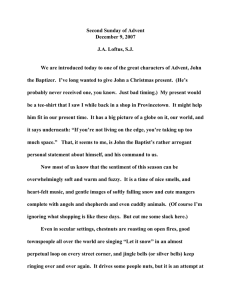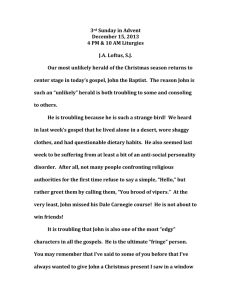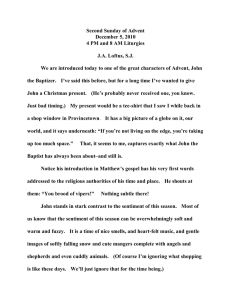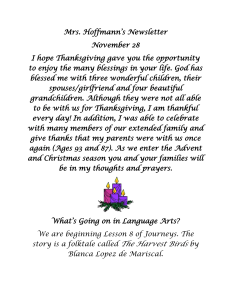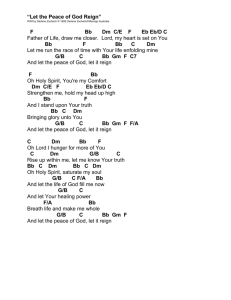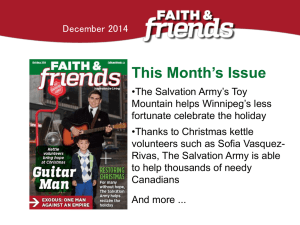3 Sunday of Advent December 12, 2010 10 AM Liturgy
advertisement
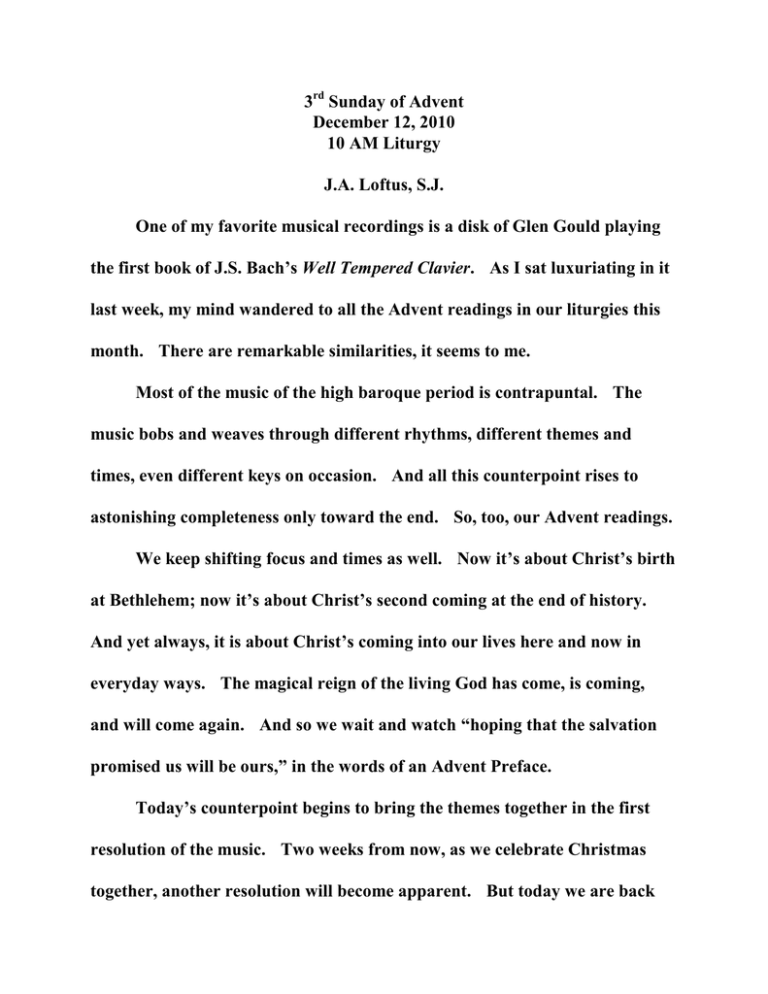
3rd Sunday of Advent December 12, 2010 10 AM Liturgy J.A. Loftus, S.J. One of my favorite musical recordings is a disk of Glen Gould playing the first book of J.S. Bach’s Well Tempered Clavier. As I sat luxuriating in it last week, my mind wandered to all the Advent readings in our liturgies this month. There are remarkable similarities, it seems to me. Most of the music of the high baroque period is contrapuntal. The music bobs and weaves through different rhythms, different themes and times, even different keys on occasion. And all this counterpoint rises to astonishing completeness only toward the end. So, too, our Advent readings. We keep shifting focus and times as well. Now it’s about Christ’s birth at Bethlehem; now it’s about Christ’s second coming at the end of history. And yet always, it is about Christ’s coming into our lives here and now in everyday ways. The magical reign of the living God has come, is coming, and will come again. And so we wait and watch “hoping that the salvation promised us will be ours,” in the words of an Advent Preface. Today’s counterpoint begins to bring the themes together in the first resolution of the music. Two weeks from now, as we celebrate Christmas together, another resolution will become apparent. But today we are back with the most unlikely herald of the season, John the Baptizer. In last week’s gospel, John was all spitfire. There was, and still is, nothing at all subtle in him. Last week, rather than a “hello,” he shouted into the faces of the religious authorities: “You brood of vipers!” Today, he sits more forlorn and more tired in prison awaiting his sure death. And he struggles with what sound like doubts. (Parenthetically, this might be comfort for those of us who retain our own doubts about all this kingdom stuff, all this reign of justice and peace and harmony that still has not yet appeared in our own worlds.) John wonders whether it all has been real. Whether it’s been worth it? Whether his impending death will have made any difference? (That too might sound familiar to some of us today.) John has been looking for the signs of the coming reign of God all his life. He got the repentance part. He got the baptizer part. He got the deep conviction part. But signs are hard to read. One can never be completely sure. So he sends friends to the “one whose sandals he knows he is not worthy to carry.” John needs to know before he dies “is this the One”? Is this Jesus really the sign? Jesus quickly provides a counterpoint’s resolution. He deftly brings 2 together past, present and future by quoting the prophet Isaiah. “Go and tell John what you see!” The signs of the reign of God are the same as they always have been and always will be. And those signs are not only the usual signs of Christmas; they are not only about a tiny baby in a manger, not about softly falling snow in a star-lit heaven (a highly unlikely scene in Palestine at any time anyway). The signs of Christmas are not only about singing angels, and sleepy shepherds, and visiting potentates from the East. Jesus knows the real signs of God’s reign, the reign that dawns at Christmas. The blind regain their sight. The lame walk. Lepers are cleansed. The deaf hear. The dead are raised. And the poor have the good news proclaimed to them. John has been right all along. The coming of God’s reign into human history is hard work. It is not easy–even for God–to make all things right in this world. Jesus then says to the crowd: What did you expect the herald of the kingdom to look like? A soft, warm and fuzzy preacher? No, John did have it right and “he is more than a prophet.” He walked the walk. Today’s liturgical oratorio gets an added chorus from James’ letter. He tells us to be patient, yes. To wait! But he also tells us not to be passive. Advent is an invitation. It is a challenge. And it comes with a warning too. 3 This liturgy is a stark reminder that the Christmas we still wait for is not just an invitation to savor the lights of the season. It is an invitation to actively dispel the darkness. There is a difference. The invitation is to dispel the darkness wherever we find it in our own hearts and in our own worlds. Like Isaiah before us, and Jesus with us, and James in his own way, we too will know the signs of the reign of God, that the Light of the World is arriving, when we create and nourish and celebrate: that the blindness all around us and in us is receding; that the crippled in our lives (whether physically, emotionally, or spiritually crippled), are again stretching, standing and even walking; when the lepers in our church and in our cultures are welcomed to the table in graciousness and with warmth; when the dead and dying in our midst see a glimmer of the Light. And we will know most assuredly that Christmas is here when the poor, the poor in so many different ways, hear nothing but good news because of us. In the end, the beauty of a magnificent baroque masterpiece becomes a real Christmas Oratorio. But it is only an invitation. The world still awaits our response. 4

